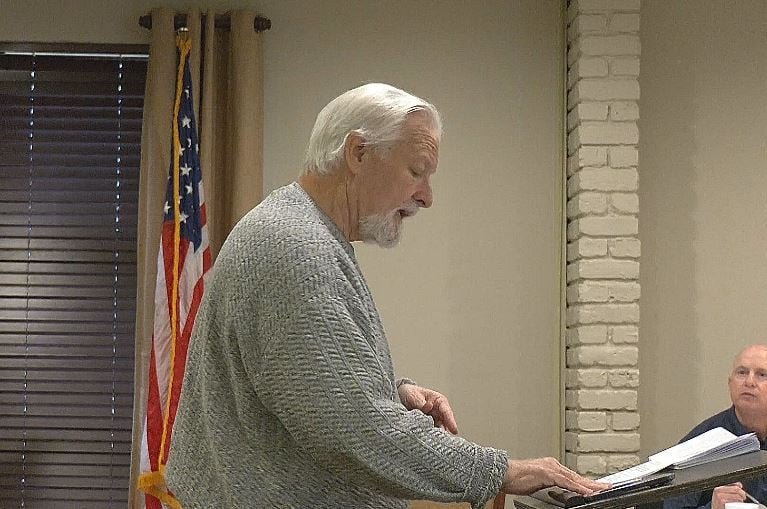MSU Field Day Highlighted Current Row Crop Concerns

Trent Irby, Mississippi State University Extension Service soybean specialist, updated ag industry personnel on the issues facing the state’s soybean crop. MSU gathered specialists June 17, 2014 at the Delta Research and Extension Center in Stoneville, Mississippi to address weed, insect, disease and plant development concerns related to the challenge of another growing season pushed off schedule by a late, wet spring.
(Photo by MSU MAFES/David Ammon)
BY BONNIE COBLENTZ
MSU Ag Communications
STONEVILLE, Miss. — Mississippi State University personnel gathered Tuesday to address weed, insect, disease and plant development concerns related to the challenge of another growing season pushed off schedule by a late, wet spring.
The MSU Delta Research and Extension Center in Stoneville stationed 13 Extension and research personnel at eight field stops to discuss soybean, corn, rice, cotton and peanut production at the half-day event. They summarized current crop conditions, discussed the challenges producers face and answered specific questions.
Tom Allen, an Extension Service plant pathologist and Mississippi Agricultural and Forestry Experiment Station researcher, designed the program to address midseason information needs.
“We assembled our Extension and research specialists in the middle of the growing season so we could address some of the major row crop concerns as they are occurring in the field,” Allen said.
He updated attendees on MSU crop disease research and discussed proper timing of fungicide applications. Allen specifically addressed the growing concern over frogeye leaf spot, an important soybean disease that is becoming resistant to chemicals commonly used to control this problem. Research is focused on how to best use effective fungicides without allowing disease resistance to increase.
Planting challenges
A repeated theme was planting crops over a longer-than-normal period of time, which creates a situation where crops are at dramatically different stages of development. Corn was planted mostly on time, but soybeans, rice and cotton were planted over a much longer time frame.
“Some soybeans are still in the bag, and others are at the R4 growth stage,” said Trent Irby, Extension soybean specialist. “There is a big range in development. I’ve talked to some producers about soybean varieties for planting and fungicide application timing at the same time.”
Rice
Bobby Golden, Experiment Station agronomist, said the state is growing two rice crops.
“There is an early rice crop planted before the spring rains and a later crop planted as late as the second week of June,” he said. “Because of the late plantings and frequent rains through May, we’re behind on a lot of management options.”
Ideally, rice fields are flooded after weed treatments, and nitrogen fertilizer is applied at a specific point in the plants’ development. This year, rains kept fields from drying out, and many producers had to apply fertilizer to muddy soils in order to control weeds by flooding.
“We’re not in the best management scenario, but our growers are making do,” Golden said. “You can grow a good rice crop spoon-feeding nitrogen to the crop by slowly adding it to the flooded fields at a rate the plants can absorb.”
Rice is also facing challenges from herbicide drift, a problem compounded by the crop being in a variety of growth stages and the use of sprays containing multiple chemicals that act in different ways.
“The drift we’re experiencing now is very complicated,” said Jason Bond, an Experiment Station weed scientist and Extension specialist. “Some of the chemical combinations are made to kill the weeds that have emerged and prevent others from germinating. If that drifts to rice, it could kill the crop in the field and prevent a replant from being successful.”
Cotton
Darrin Dodds, Extension cotton specialist, said the cotton crop was also planted in spurts as the ground became dry enough between rains for producers to get back in the fields.
“With the planting capacity we have, we got across the ground pretty quickly, but in several cases, we didn’t get pre-emergence herbicides applied prior to crop emergence,” Dodds said. “Cotton and pigweed came out at the same time, so we’ve had some issues with weed control.”
Peanuts
Mississippi is still new enough to peanut production that some diseases and insect pests that plague the traditional U.S. peanut belt have not yet become major problems, said Jason Sarver, Extension peanut specialist and MAFES researcher. An important current production factor for peanuts is the need to supply sufficient calcium.
“A lot of other plants can pull up calcium through the roots for their fruiting structures, but peanuts can’t,” Sarver said. “There has to be a direct transfer of calcium from the soil through the peanut pod wall. Peanut fields need a minimum of 500 pounds of calcium per acre with a 3-1 ratio of calcium to potassium for proper pod and kernel development.”
Soybeans
MSU experts addressed problems with fall armyworms, which are showing up this summer. Angus Catchot, Extension entomologist, said the rice strain of the fall armyworm prefers grasses but has been a problem in some soybean fields this year.
“We’ve had several instances where fields were grassy because producers have not been able to make herbicide applications due to extensive rain,” Catchot said. “Now that the ground dried up enough for them to finally be able to spray herbicides, they killed the grass and the armyworms went immediately to the soybeans.
“It happens very fast, and armyworms can strip the plants in just a few days,” he said. “If you have grassy beans and are making a herbicide application, scout the grass. If armyworms are present, they are easy to control with pyrethroid insecticides applied along with the herbicide.”
Scouting for insect pests is vital, and the experts urged producers to follow MSU recommendations and only treat when pest numbers reach certain thresholds.
Irrigation
Irrigation is always a concern of producers in the Delta, and Experiment Station and Extension personnel Lyle Pringle and Jason Krutz emphasized the importance of efficient irrigation management. Much of their work is aimed at pinpointing the most efficient way to schedule irrigation to conserve water and reduce irrigation costs.
“Three tools will make us better irrigators in the Delta,” Krutz said. “Producers can become much more efficient if they will use a computerized hole selection tool for polypipe irrigation systems, surge valves to intermittently distribute water across a field and soil moisture sensors to know when to irrigate.”
They said in-field demonstrations reliably cut water usage almost in half while maintaining yields.
More information and current updates from MSU researchers and Extension experts is available on the Mississippi Crop Situation blog at http://www.mississippi-crops.com/.





Leave a Reply